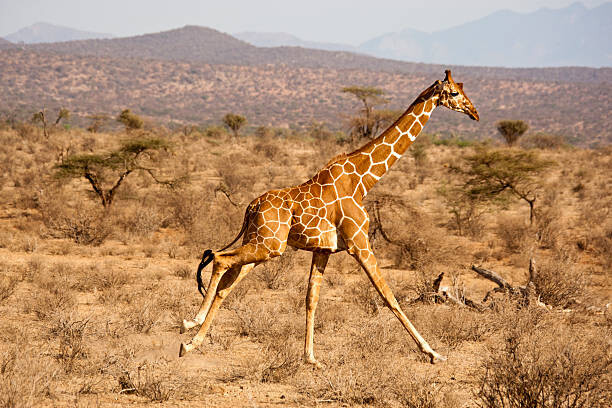nightglow.info – The reticulated giraffe, Giraffa camelopardalis reticulata, is a breathtakingly beautiful creature and one of the most iconic symbols of the African savanna. With its striking coat pattern and towering stature, it has captivated the hearts and minds of people around the world. However, this magnificent animal faces numerous threats and is in need of urgent conservation efforts.
A Distinctive Appearance
The reticulated giraffe is easily recognizable by its unique coat pattern. Its rich brown fur is adorned with a network of sharp-edged, polygonal shapes outlined by thin white lines, giving it a reticulated appearance. This intricate pattern is not only visually stunning but also serves as a form of camouflage, helping the giraffe blend in with the dappled sunlight and shadows of the savanna.
A Towering Stature
As the tallest living land animal, the reticulated giraffe can reach heights of up to 18 feet (5.5 meters). This impressive stature provides several advantages, including the ability to reach the highest leaves of acacia trees, a primary food source. Their long necks and legs also allow them to spot predators from afar, giving them a crucial advantage in the wild.
Social Behavior
Reticulated giraffes are social animals that live in small groups called herds. These herds typically consist of females and their offspring, while adult males often live solitary lives or form loose bachelor groups. Within a herd, individuals maintain complex social relationships, communicating through a variety of vocalizations and body language.
Habitat and Diet
Reticulated giraffes are primarily found in the arid and semi-arid regions of East Africa, particularly in Kenya, Somalia, and Ethiopia. They inhabit open woodlands and savannas, where they can find an abundance of acacia trees and other vegetation.
Their diet consists mainly of the leaves, flowers, and fruits of acacia trees. These trees provide essential nutrients and water, especially during the dry season when other food sources may be scarce. To reach the highest leaves, giraffes have evolved long, flexible tongues that can strip leaves from thorny branches without injuring their mouths.
Conservation Challenges
Despite their iconic status, reticulated giraffes are facing significant conservation challenges. Habitat loss, poaching, and human-wildlife conflict are among the primary threats to their survival. As human populations continue to grow and expand into giraffe habitats, these animals are increasingly losing their homes and facing competition for resources.
Furthermore, poaching for bushmeat and traditional medicine has decimated giraffe populations in some areas. The illegal trade in giraffe products, such as skin and bones, also poses a serious threat. Additionally, human-wildlife conflict can lead to the killing of giraffes that are perceived as a threat to livestock or crops.
Conservation Efforts
To address these challenges, a number of conservation organizations are working to protect reticulated giraffes and their habitats. These efforts include habitat protection, anti-poaching patrols, community outreach programs, and captive breeding initiatives.
Community-based conservation programs are particularly important, as they involve local communities in wildlife conservation efforts. By empowering local people to protect wildlife and their habitats, these programs can help to ensure the long-term survival of species like the reticulated giraffe.
Conclusion
The reticulated giraffe is a truly remarkable animal that deserves our admiration and protection. Its unique appearance, social behavior, and ecological role make it an invaluable part of the African savanna ecosystem. However, the future of this species hangs in the balance due to a variety of threats. By supporting conservation efforts and raising awareness about the plight of the reticulated giraffe, we can help to ensure that this majestic creature continues to grace the African savanna for generations to come.
